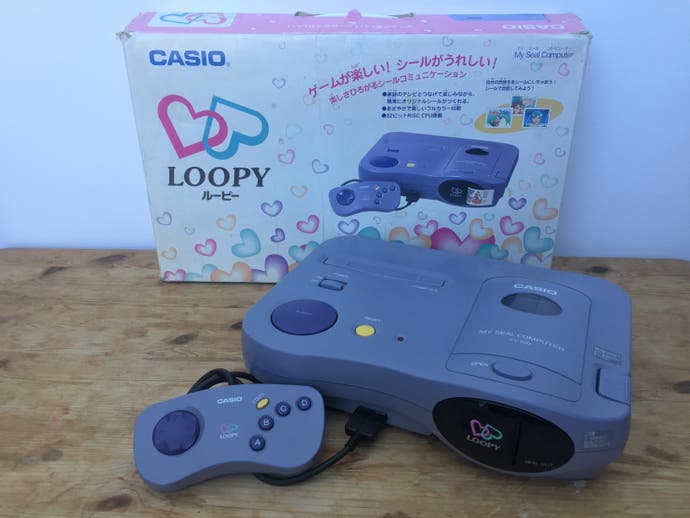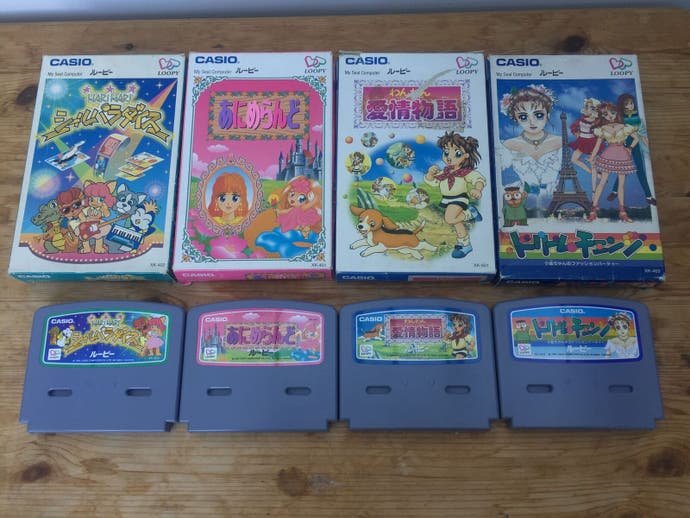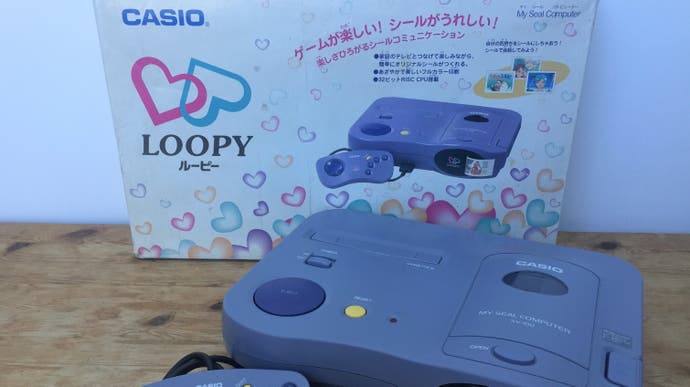In the Loopy: the story of Casio's crazy 90s console
Casio made a bid for hardware glory in the 90s - and it went about it in the strangest of ways.
As a gaming machine, the Casio Loopy isn't particularly good. But as a collection of ideas, it's fascinating, a ragtag novelty that may well have been ahead of its time if it wasn't so scatty.
Don't be surprised if you've never heard of the Loopy - it was only ever released in Japan, its life limited to a couple of years before it disappeared into obscurity. The Loopy wasn't the first home console released by Casio - that would be the ill-fated PV-1000 from 1983 - but it was certainly the last. When I contacted Casio to find out more details about the Loopy, they were surprised that someone so far from Japan would remember their strange console from more than 20 years ago.
But I'm not the only person to show interest in this obscure piece of Japanese gaming history. Thanks to its short lifetime and exclusivity to Japan, the Loopy is extremely rare on these shores and has become something of a prize possession among British retro game collectors. Quang Nguyen is one such collector: he paid £180 for a boxed Casio Loopy and four games back in 2013, but he told me that prices have been steadily rising since then. He reckons a boxed console on its own would now sell for between £130 and £160, with an unboxed one going for maybe £60-90.
The Casio PR department was happy to help me find out more information on the Loopy, and after an extensive search, they found two engineers who worked on the console 20-odd years ago: Tetsuya Hayashi and Kunihiro Matsubara. Unfortunately, due to schedule clashes and the eight-hour time difference, I couldn't speak to them in person, but they agreed to answer a few questions by email.

The 32-bit Loopy was released in October 1995, nearly a year after the PlayStation, so I asked how the Loopy compared with Sony's console in terms of specs. Interestingly, they looked to the older 16-bit consoles during development: "At the time, Nintendo's Super-Famicom, Sega's Mega Drive and NEC's PC Engine were the big three game consoles. We did not aim for the same kind of console, but we did study those consoles in the light of dealing with video images and aimed at the performance of the SNES, which had the highest market share. The mainstream game consoles back then used 16-bit microcomputers. In order to improve the computing performance, Loopy adopted a 32-bit microcomputer. In addition, we adopted a PCM sound source to reproduce good sound. We never directly compared the performance with the PlayStation."
Unfortunately, the Casio engineers weren't able to find exact figures for how many units the Loopy sold in its lifetime: the nearest they could come up with was a press release issued in 1995 that says the expected first year's production would be 200,000 units. Whether that many consoles were actually made - and how many were eventually sold - is anyone's guess. Casio did confirm, though, that production of the console ceased in December 1998 - and that software development had ended in November 1996, with the last titles releasing in 1997.
The unique selling point of the Casio Loopy was its thermal printer. Unlike the Game Boy Printer, released a few years later in 1998, the Loopy printws in full colour, and the ten different games released for the machine all allow you to create your own adhesive scenes.
YouTuber Octav1us has been researching the Loopy, and she recently put out a video on the console. Octav1us covers retro gaming on her YouTube channel, and in particular obscure, not-so-great machines from the past. "I just absolutely adore consoles that are rubbish," she says. "I think it's really important in video gaming that we never try and brush the mistakes like that under the rug because we need to have them, we need to learn from them. I think with the retro gaming community we're always exceptionally interested in consoles that nobody else knows about. Everyone always talks about Sega and Nintendo - no one ever mentions Casio and Grandstand, they just get kind of forgotten about."
I asked her what she thought of the Loopy's unique sticker-making function. "The whole sticker thing... to be honest I think they went a bit wrong by making it pretty much a sticker maker which was marketed as a console. If it had been marketed like that maybe it wouldn't be quite so embarrassingly bad, but it's just the fact that the games are supposed to appeal to women but it's all about sticker making. There's one that's literally just a comic strip - you can't do anything, you just click from frame to frame, and then you can print out the stickers and make your own comic book, yay. Like, that's not a game, is it?"
She does quite admire the style of the console, though. "It looks like an amoeba, a single-celled life form. It has that enormous eject button, it's just huge and it's so satisfying to press as well. It's just fantastic. And I do enjoy how the sticker maker takes up a good 45 per cent of the console. It's like they're not even trying to hide it, this is just a sticker maker and we don't care. I find that amusing. Although I must say that the way you get the stickers out is really nice. You press that sticker button and the scissors inside clip it, and that's really satisfying. I probably would have just done that if I'd had it as a kid - just cut stickers all the time."
Another interesting quirk of the Loopy is that it was marketed entirely to women. It's not the first console to be marketed that way - that would be the Super Lady Cassette Vision, a 1980s Japanese console that was basically just a pink version of Epoch's Super Cassette Vision in a matching briefcase - but the Loopy is certainly in a select club. It's an interesting decision: clearly the marketers could see that women at the time represented a gap in the gaming market, but the message it sends is that regular consoles are just for boys. (And any brief glimpse at 1990s video game marketing would pretty much confirm that bias.) Not only that, the Loopy's range of ultra-simplistic games seems to indicate that girls should be content with barely interactive sticker albums.
I asked Octav1us what she thought about the Loopy being marketed to women, and for her it's yet another reminder of the abuse she received for being a girl who's into games. "It really annoyed me because it completely alienates women by saying you need to have a console specifically for you. The amount of times I got told I shouldn't be playing games because I was a girl... I remember when I was 9 years old, there was a kid at school who told me I shouldn't be allowed to play games because that was a boy thing, and that kind of thing really sticks with you. And when you become a woman, you get really salty about it because you remember all of this stuff. The idea of marketing a console specifically to women is kind of saying 'OK so you need to have this thing, boys can have the other thing', rather than just being like, 'look, it doesn't matter what gender you are, just play a friggin' SNES and shut up'."
"I think it probably did have good intentions, but it was done in completely the wrong way. I mean in terms of visuals, I think it's adorable, I think the games look really nice. I think they're very cute, and the characters in them are very sweet. But, you know, you want to be able to jump around like Mario or stab someone in the face - shoot things and stuff. Just because you're a female doesn't mean you're not into that, and it's just this annoying idea that women are all sort of like sweetness and light, when actually we can be just as psychotic as men."
"It's just hilarious - just the sheer misogyny of it. But then again I imagine that the culture's very different in Japan in terms of the kind of thing that girls are expected to enjoy. In any case, it doesn't surprise me that this was never planned for release over in the Western world."
When I asked Hayashi and Matsubara about the Loopy's marketing, it was interesting to discover that originally the console wasn't targeted specifically at women: "People say the Loopy targeted girls, but when we started development of the game console, that was not our intention. However, because many girls liked to play with stickers, and the fact that the Casio electronic personal organizer for children was popular with early teen girls, the first-released software titles included Animelando, which allowed users to design and print girl anime characters, HARI HARI Seal Paradise, which let users coordinate cute animal characters and make one-of-a-kind stickers, and the Wan Wan Aijo Monogatari role-playing game in which users nurture puppies and clear growth stages to get stickers; the collected stickers would make a story book. Thus, the sales strategy ended up as being targeted at girls when the console was launched."
Curiously, the Loopy appeared at almost exactly the same time as another sticker phenomenon that was also heavily aimed towards girls: Print Club, or 'Purikura'. The first Purikura machine was released by Atlus in July 1995, but Purikura didn't really take off until it was featured on a TV show hosted by the monumentally popular boy band SMAP a year or so later. Nowadays the machines are standard issue for any Japanese arcade - essentially they are massive photo booths that let you digitally customize your photos with words and graphics and then print them out on stickers.

I asked the Casio engineers whether the Loopy was inspired by the development of Purikura machines, or whether it was an independent idea. "The original development concept or idea was to add a sticker printing function, which we had with Casio label printers, to a game console," they replied. "The purpose was to create a new entertainment device that would have an added element of creativity. It was technically possible for us to develop a Purikura-like device by connecting it to a camcorder, because we already had a cartridge that allowed users to print images from the video input, but Purikura was not the point of origin for us."
The cartridge that they mention was a peripheral called 'Magical Shop', and it allowed you to capture screenshots from an external video source, like a VCR or DVD player, and then add graphics to the image. So if you had, say, a video of yourself, you could add graphics to it and essentially replicate the functionality of a Purikura machine. But the Magical Shop was expensive at 14,800 yen, which was on top of the 25,000 yen cost of the console itself. For comparison, the Sony PlayStation cost 37,000 yen at launch. Nguyen says the Magical Shop peripheral is "a relatively rare piece these days, as not that many were sold, but they show up from time to time".
Weirdly, whereas Purikura machines were very much a social experience, with large booths designed to hold groups of friends, the Casio Loopy was a strictly solo affair - it only had one controller port. Octav1us thinks it was a very odd decision: "I don't understand that. I don't know exactly what kind of games they could have made two player - I don't know, sticker-making competitions or something like that, or maybe girls could work together to make the stickers."

"It's a very lonely console, you know? It feels sad. With [Purikura] you have that public aspect. It's not just you, by yourself, sat in a room printing out stickers. How sad is that?"
One thing that struck me about the Loopy was that a lot of its ideas were pretty good, but that they were either executed poorly or just didn't work as well as intended. Printing out stickers from your console is a fun idea, but the games in which you create the stickers are incredibly shallow. It seems like the idea was to make games about making stickers rather than to make fun games that also have a sticker-making element - perhaps if things had been the other way around, the Loopy would have made more of a lasting impact. And pushing the console towards girls seems misguided in hindsight.
Elements of the Loopy can be seen in later technology. The Game Boy Printer essentially does the same things as the Loopy and, coupled with the Game Boy Camera, would see great success in the late 90s. Perhaps if the Loopy had a built-in camera of its own, it would have seen far greater sales, particularly as it would have basically been a Purikura machine for home use. Then again, digital cameras were still in their infancy in the early 90s, so no doubt the cost would have been prohibitive. But the Loopy did have the ability to add text and graphics to still images from TV and film thanks to the Magical Shop peripheral, basically making it a meme generator long before memes became widespread. If only the Loopy had been able to connect to the internet back in 1995.
It's like the Loopy was simultaneously ahead of its time and yet also hopelessly out of touch. A meme maker with an audience of one. A high-tech sticker machine with outdated notions of femininity. The sense of missed opportunity is palpable, and Octav1us sums it up better than I can: "It's just overall an interesting, quirky, frustrating, annoying console - it evokes all of the emotions, and that's why it's good."



